Occupational Therapy - PDF
VerifiedAdded on 2021/06/14
|9
|2708
|75
AI Summary
Contribute Materials
Your contribution can guide someone’s learning journey. Share your
documents today.
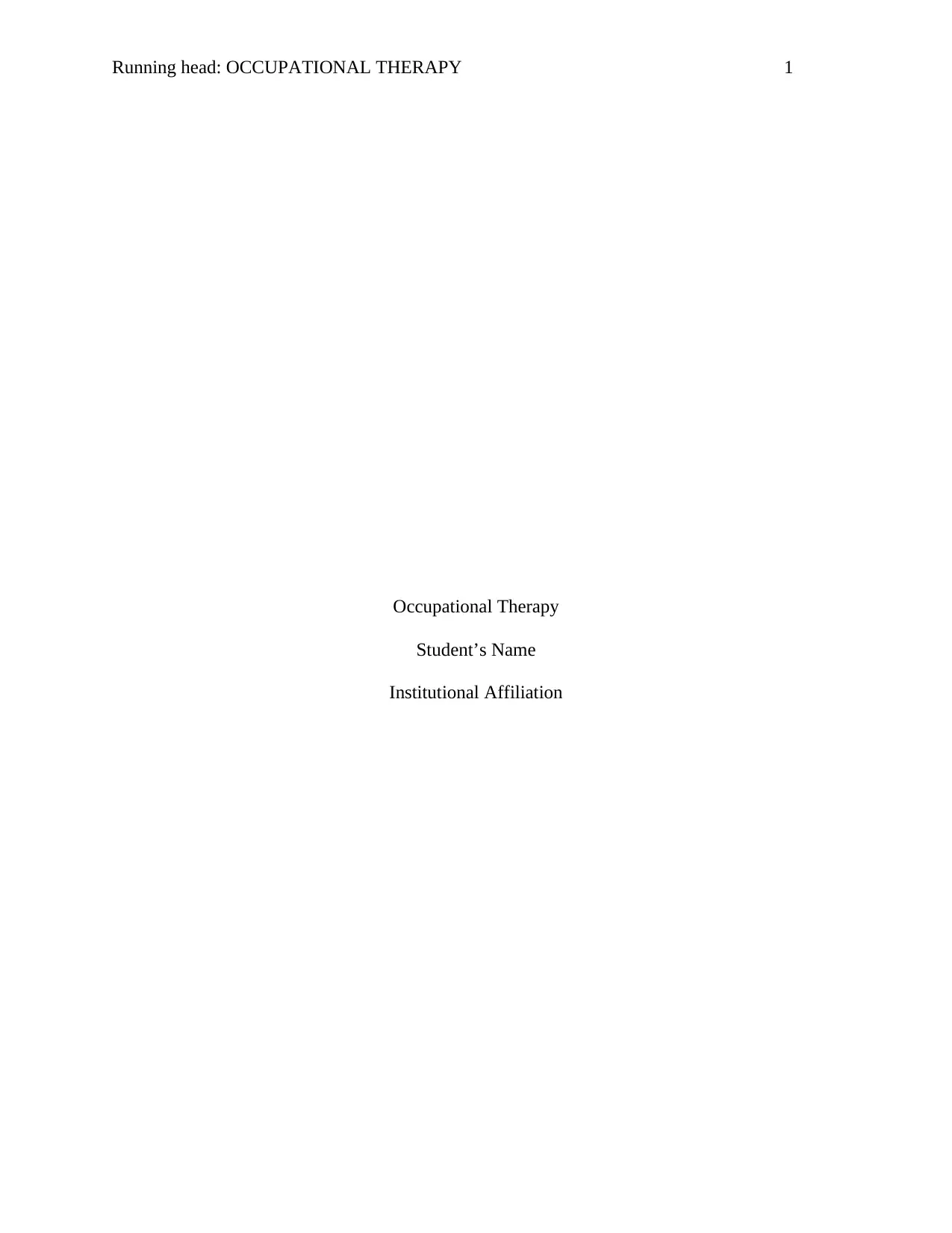
Running head: OCCUPATIONAL THERAPY 1
Occupational Therapy
Student’s Name
Institutional Affiliation
Occupational Therapy
Student’s Name
Institutional Affiliation
Secure Best Marks with AI Grader
Need help grading? Try our AI Grader for instant feedback on your assignments.
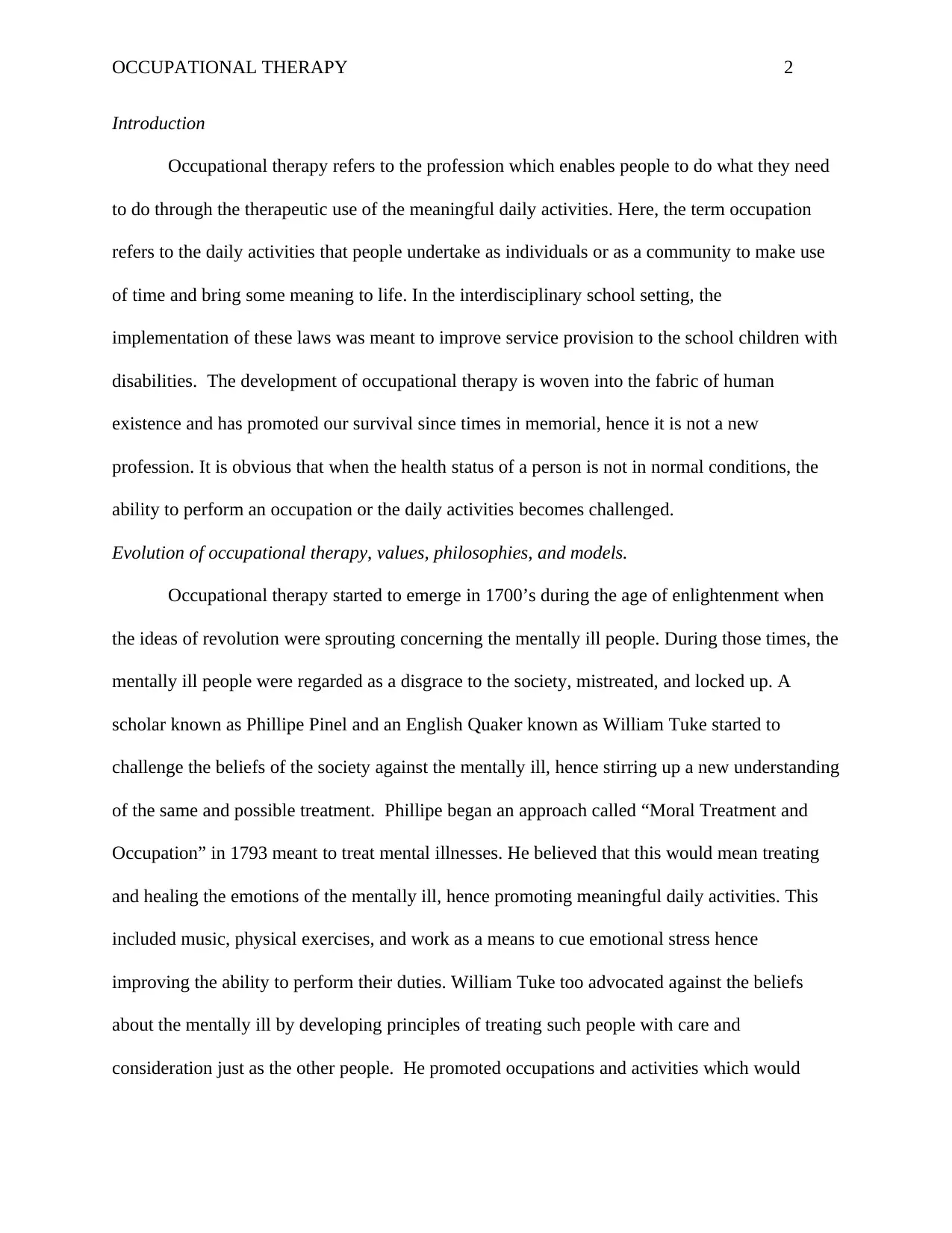
OCCUPATIONAL THERAPY 2
Introduction
Occupational therapy refers to the profession which enables people to do what they need
to do through the therapeutic use of the meaningful daily activities. Here, the term occupation
refers to the daily activities that people undertake as individuals or as a community to make use
of time and bring some meaning to life. In the interdisciplinary school setting, the
implementation of these laws was meant to improve service provision to the school children with
disabilities. The development of occupational therapy is woven into the fabric of human
existence and has promoted our survival since times in memorial, hence it is not a new
profession. It is obvious that when the health status of a person is not in normal conditions, the
ability to perform an occupation or the daily activities becomes challenged.
Evolution of occupational therapy, values, philosophies, and models.
Occupational therapy started to emerge in 1700’s during the age of enlightenment when
the ideas of revolution were sprouting concerning the mentally ill people. During those times, the
mentally ill people were regarded as a disgrace to the society, mistreated, and locked up. A
scholar known as Phillipe Pinel and an English Quaker known as William Tuke started to
challenge the beliefs of the society against the mentally ill, hence stirring up a new understanding
of the same and possible treatment. Phillipe began an approach called “Moral Treatment and
Occupation” in 1793 meant to treat mental illnesses. He believed that this would mean treating
and healing the emotions of the mentally ill, hence promoting meaningful daily activities. This
included music, physical exercises, and work as a means to cue emotional stress hence
improving the ability to perform their duties. William Tuke too advocated against the beliefs
about the mentally ill by developing principles of treating such people with care and
consideration just as the other people. He promoted occupations and activities which would
Introduction
Occupational therapy refers to the profession which enables people to do what they need
to do through the therapeutic use of the meaningful daily activities. Here, the term occupation
refers to the daily activities that people undertake as individuals or as a community to make use
of time and bring some meaning to life. In the interdisciplinary school setting, the
implementation of these laws was meant to improve service provision to the school children with
disabilities. The development of occupational therapy is woven into the fabric of human
existence and has promoted our survival since times in memorial, hence it is not a new
profession. It is obvious that when the health status of a person is not in normal conditions, the
ability to perform an occupation or the daily activities becomes challenged.
Evolution of occupational therapy, values, philosophies, and models.
Occupational therapy started to emerge in 1700’s during the age of enlightenment when
the ideas of revolution were sprouting concerning the mentally ill people. During those times, the
mentally ill people were regarded as a disgrace to the society, mistreated, and locked up. A
scholar known as Phillipe Pinel and an English Quaker known as William Tuke started to
challenge the beliefs of the society against the mentally ill, hence stirring up a new understanding
of the same and possible treatment. Phillipe began an approach called “Moral Treatment and
Occupation” in 1793 meant to treat mental illnesses. He believed that this would mean treating
and healing the emotions of the mentally ill, hence promoting meaningful daily activities. This
included music, physical exercises, and work as a means to cue emotional stress hence
improving the ability to perform their duties. William Tuke too advocated against the beliefs
about the mentally ill by developing principles of treating such people with care and
consideration just as the other people. He promoted occupations and activities which would
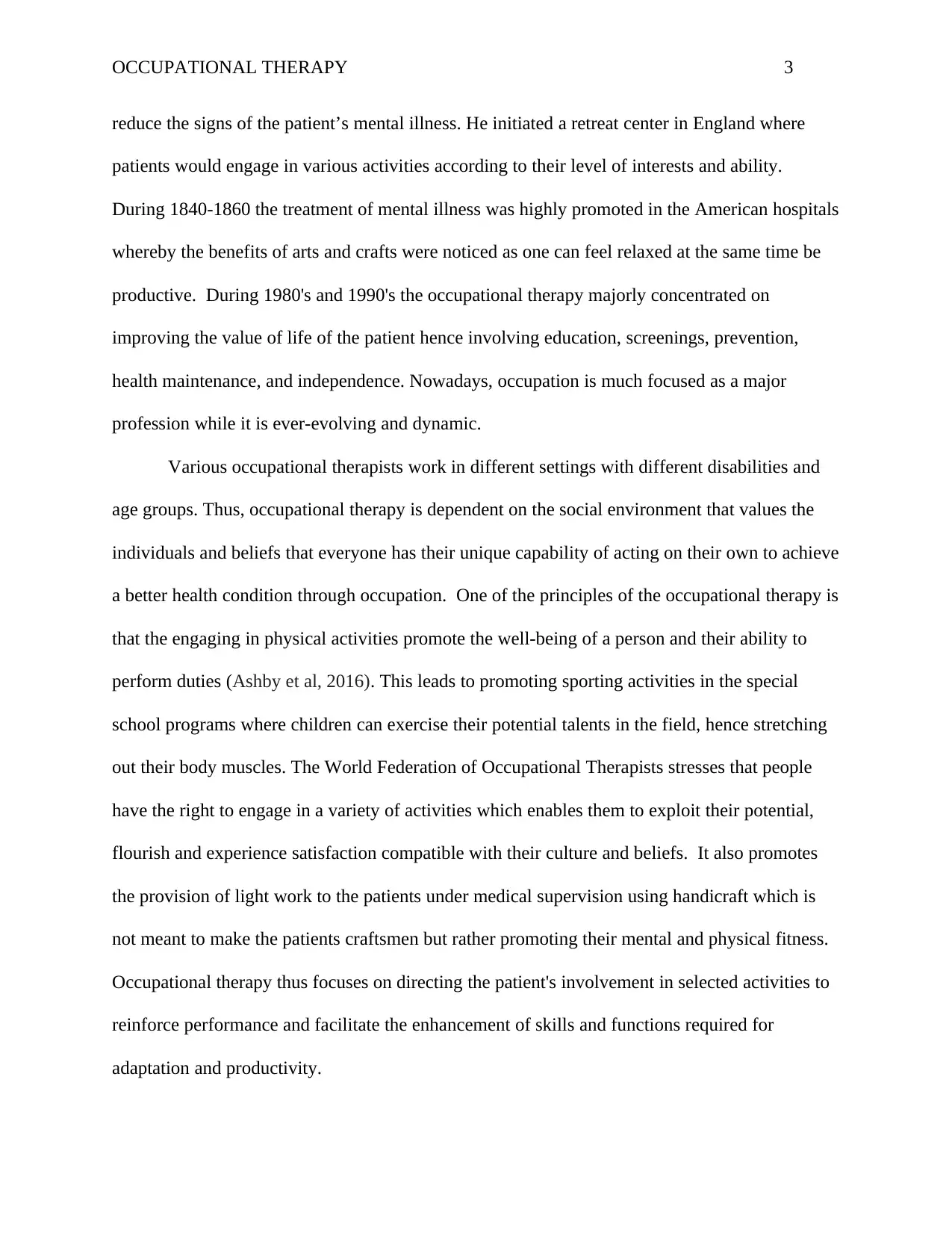
OCCUPATIONAL THERAPY 3
reduce the signs of the patient’s mental illness. He initiated a retreat center in England where
patients would engage in various activities according to their level of interests and ability.
During 1840-1860 the treatment of mental illness was highly promoted in the American hospitals
whereby the benefits of arts and crafts were noticed as one can feel relaxed at the same time be
productive. During 1980's and 1990's the occupational therapy majorly concentrated on
improving the value of life of the patient hence involving education, screenings, prevention,
health maintenance, and independence. Nowadays, occupation is much focused as a major
profession while it is ever-evolving and dynamic.
Various occupational therapists work in different settings with different disabilities and
age groups. Thus, occupational therapy is dependent on the social environment that values the
individuals and beliefs that everyone has their unique capability of acting on their own to achieve
a better health condition through occupation. One of the principles of the occupational therapy is
that the engaging in physical activities promote the well-being of a person and their ability to
perform duties (Ashby et al, 2016). This leads to promoting sporting activities in the special
school programs where children can exercise their potential talents in the field, hence stretching
out their body muscles. The World Federation of Occupational Therapists stresses that people
have the right to engage in a variety of activities which enables them to exploit their potential,
flourish and experience satisfaction compatible with their culture and beliefs. It also promotes
the provision of light work to the patients under medical supervision using handicraft which is
not meant to make the patients craftsmen but rather promoting their mental and physical fitness.
Occupational therapy thus focuses on directing the patient's involvement in selected activities to
reinforce performance and facilitate the enhancement of skills and functions required for
adaptation and productivity.
reduce the signs of the patient’s mental illness. He initiated a retreat center in England where
patients would engage in various activities according to their level of interests and ability.
During 1840-1860 the treatment of mental illness was highly promoted in the American hospitals
whereby the benefits of arts and crafts were noticed as one can feel relaxed at the same time be
productive. During 1980's and 1990's the occupational therapy majorly concentrated on
improving the value of life of the patient hence involving education, screenings, prevention,
health maintenance, and independence. Nowadays, occupation is much focused as a major
profession while it is ever-evolving and dynamic.
Various occupational therapists work in different settings with different disabilities and
age groups. Thus, occupational therapy is dependent on the social environment that values the
individuals and beliefs that everyone has their unique capability of acting on their own to achieve
a better health condition through occupation. One of the principles of the occupational therapy is
that the engaging in physical activities promote the well-being of a person and their ability to
perform duties (Ashby et al, 2016). This leads to promoting sporting activities in the special
school programs where children can exercise their potential talents in the field, hence stretching
out their body muscles. The World Federation of Occupational Therapists stresses that people
have the right to engage in a variety of activities which enables them to exploit their potential,
flourish and experience satisfaction compatible with their culture and beliefs. It also promotes
the provision of light work to the patients under medical supervision using handicraft which is
not meant to make the patients craftsmen but rather promoting their mental and physical fitness.
Occupational therapy thus focuses on directing the patient's involvement in selected activities to
reinforce performance and facilitate the enhancement of skills and functions required for
adaptation and productivity.
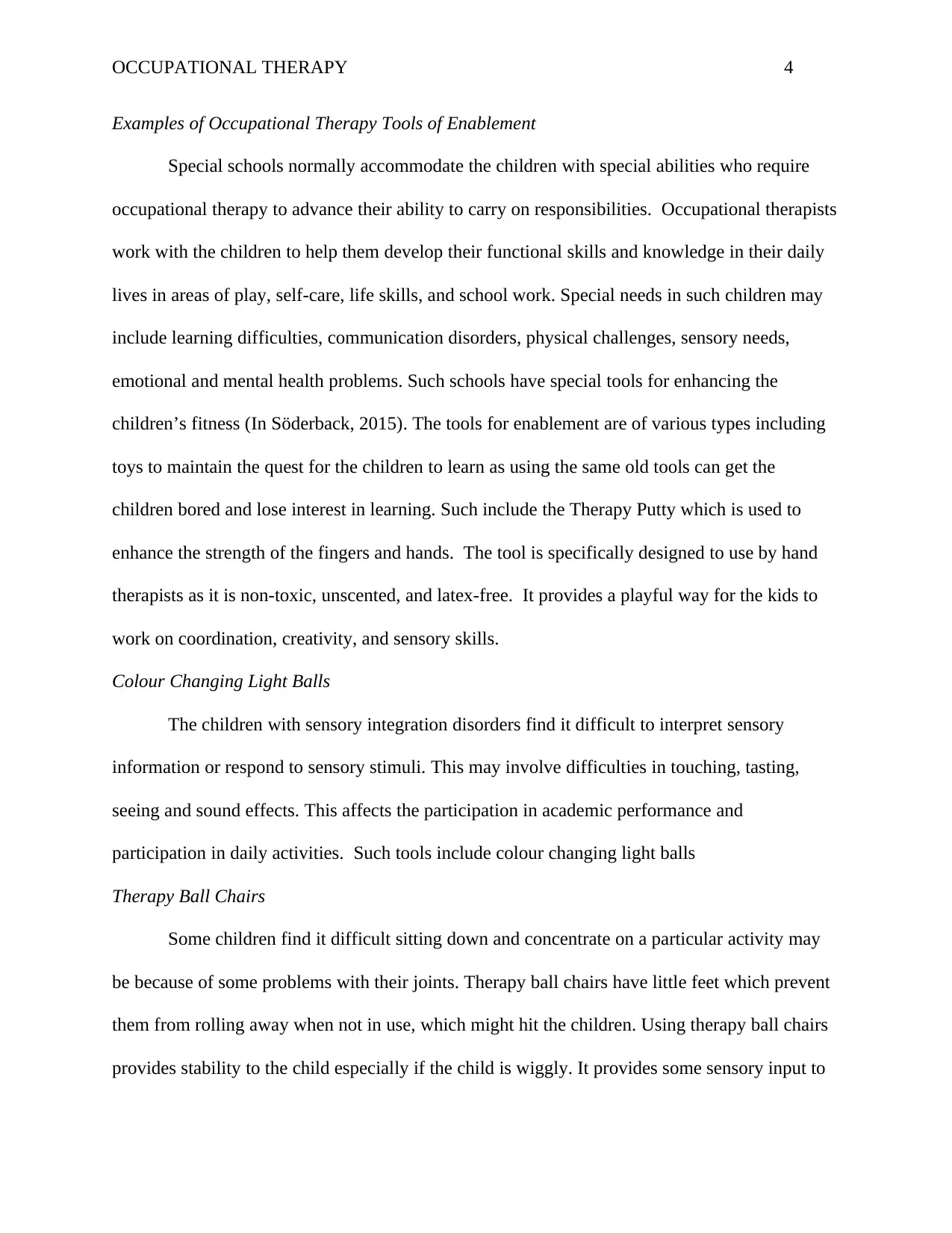
OCCUPATIONAL THERAPY 4
Examples of Occupational Therapy Tools of Enablement
Special schools normally accommodate the children with special abilities who require
occupational therapy to advance their ability to carry on responsibilities. Occupational therapists
work with the children to help them develop their functional skills and knowledge in their daily
lives in areas of play, self-care, life skills, and school work. Special needs in such children may
include learning difficulties, communication disorders, physical challenges, sensory needs,
emotional and mental health problems. Such schools have special tools for enhancing the
children’s fitness (In Söderback, 2015). The tools for enablement are of various types including
toys to maintain the quest for the children to learn as using the same old tools can get the
children bored and lose interest in learning. Such include the Therapy Putty which is used to
enhance the strength of the fingers and hands. The tool is specifically designed to use by hand
therapists as it is non-toxic, unscented, and latex-free. It provides a playful way for the kids to
work on coordination, creativity, and sensory skills.
Colour Changing Light Balls
The children with sensory integration disorders find it difficult to interpret sensory
information or respond to sensory stimuli. This may involve difficulties in touching, tasting,
seeing and sound effects. This affects the participation in academic performance and
participation in daily activities. Such tools include colour changing light balls
Therapy Ball Chairs
Some children find it difficult sitting down and concentrate on a particular activity may
be because of some problems with their joints. Therapy ball chairs have little feet which prevent
them from rolling away when not in use, which might hit the children. Using therapy ball chairs
provides stability to the child especially if the child is wiggly. It provides some sensory input to
Examples of Occupational Therapy Tools of Enablement
Special schools normally accommodate the children with special abilities who require
occupational therapy to advance their ability to carry on responsibilities. Occupational therapists
work with the children to help them develop their functional skills and knowledge in their daily
lives in areas of play, self-care, life skills, and school work. Special needs in such children may
include learning difficulties, communication disorders, physical challenges, sensory needs,
emotional and mental health problems. Such schools have special tools for enhancing the
children’s fitness (In Söderback, 2015). The tools for enablement are of various types including
toys to maintain the quest for the children to learn as using the same old tools can get the
children bored and lose interest in learning. Such include the Therapy Putty which is used to
enhance the strength of the fingers and hands. The tool is specifically designed to use by hand
therapists as it is non-toxic, unscented, and latex-free. It provides a playful way for the kids to
work on coordination, creativity, and sensory skills.
Colour Changing Light Balls
The children with sensory integration disorders find it difficult to interpret sensory
information or respond to sensory stimuli. This may involve difficulties in touching, tasting,
seeing and sound effects. This affects the participation in academic performance and
participation in daily activities. Such tools include colour changing light balls
Therapy Ball Chairs
Some children find it difficult sitting down and concentrate on a particular activity may
be because of some problems with their joints. Therapy ball chairs have little feet which prevent
them from rolling away when not in use, which might hit the children. Using therapy ball chairs
provides stability to the child especially if the child is wiggly. It provides some sensory input to
Secure Best Marks with AI Grader
Need help grading? Try our AI Grader for instant feedback on your assignments.
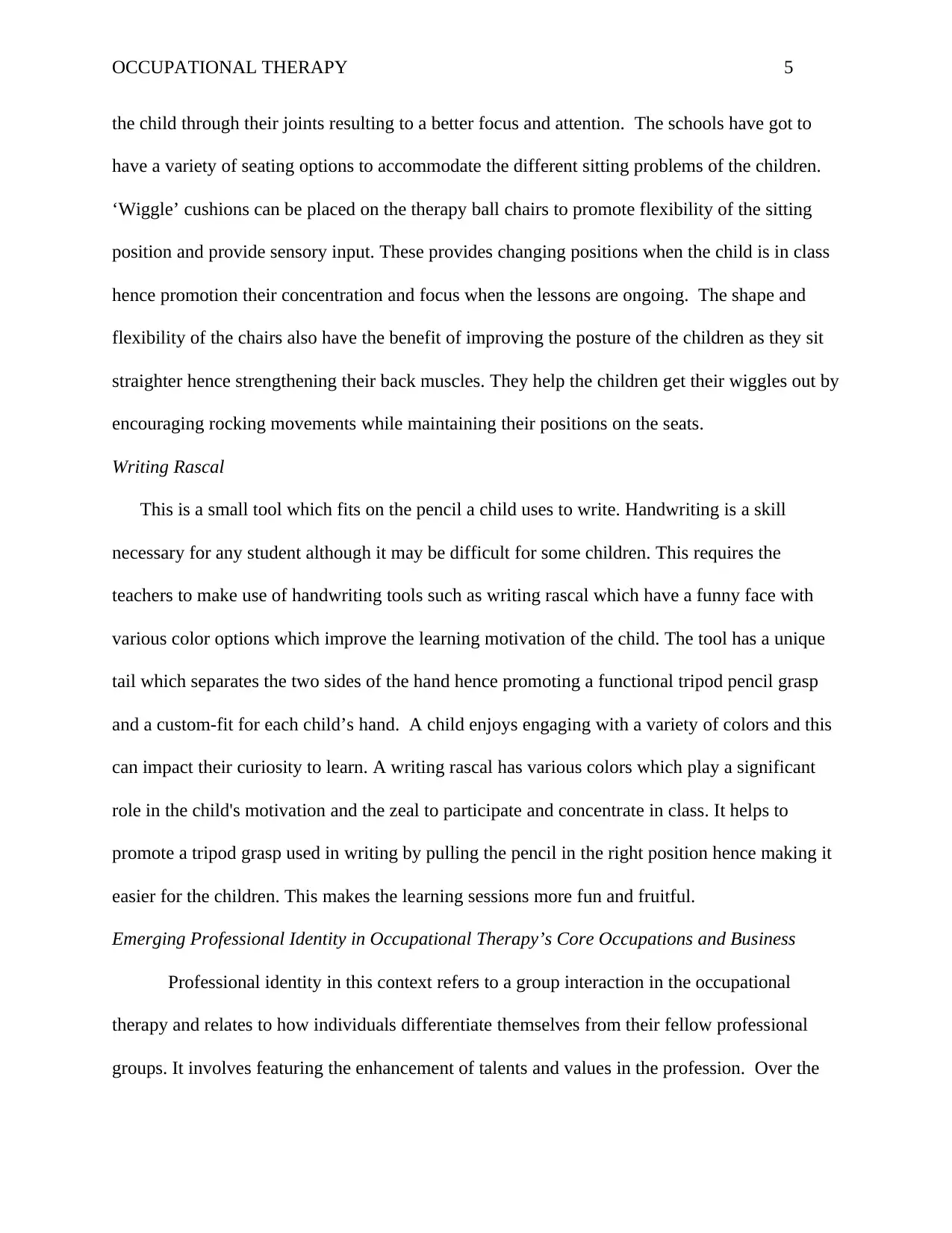
OCCUPATIONAL THERAPY 5
the child through their joints resulting to a better focus and attention. The schools have got to
have a variety of seating options to accommodate the different sitting problems of the children.
‘Wiggle’ cushions can be placed on the therapy ball chairs to promote flexibility of the sitting
position and provide sensory input. These provides changing positions when the child is in class
hence promotion their concentration and focus when the lessons are ongoing. The shape and
flexibility of the chairs also have the benefit of improving the posture of the children as they sit
straighter hence strengthening their back muscles. They help the children get their wiggles out by
encouraging rocking movements while maintaining their positions on the seats.
Writing Rascal
This is a small tool which fits on the pencil a child uses to write. Handwriting is a skill
necessary for any student although it may be difficult for some children. This requires the
teachers to make use of handwriting tools such as writing rascal which have a funny face with
various color options which improve the learning motivation of the child. The tool has a unique
tail which separates the two sides of the hand hence promoting a functional tripod pencil grasp
and a custom-fit for each child’s hand. A child enjoys engaging with a variety of colors and this
can impact their curiosity to learn. A writing rascal has various colors which play a significant
role in the child's motivation and the zeal to participate and concentrate in class. It helps to
promote a tripod grasp used in writing by pulling the pencil in the right position hence making it
easier for the children. This makes the learning sessions more fun and fruitful.
Emerging Professional Identity in Occupational Therapy’s Core Occupations and Business
Professional identity in this context refers to a group interaction in the occupational
therapy and relates to how individuals differentiate themselves from their fellow professional
groups. It involves featuring the enhancement of talents and values in the profession. Over the
the child through their joints resulting to a better focus and attention. The schools have got to
have a variety of seating options to accommodate the different sitting problems of the children.
‘Wiggle’ cushions can be placed on the therapy ball chairs to promote flexibility of the sitting
position and provide sensory input. These provides changing positions when the child is in class
hence promotion their concentration and focus when the lessons are ongoing. The shape and
flexibility of the chairs also have the benefit of improving the posture of the children as they sit
straighter hence strengthening their back muscles. They help the children get their wiggles out by
encouraging rocking movements while maintaining their positions on the seats.
Writing Rascal
This is a small tool which fits on the pencil a child uses to write. Handwriting is a skill
necessary for any student although it may be difficult for some children. This requires the
teachers to make use of handwriting tools such as writing rascal which have a funny face with
various color options which improve the learning motivation of the child. The tool has a unique
tail which separates the two sides of the hand hence promoting a functional tripod pencil grasp
and a custom-fit for each child’s hand. A child enjoys engaging with a variety of colors and this
can impact their curiosity to learn. A writing rascal has various colors which play a significant
role in the child's motivation and the zeal to participate and concentrate in class. It helps to
promote a tripod grasp used in writing by pulling the pencil in the right position hence making it
easier for the children. This makes the learning sessions more fun and fruitful.
Emerging Professional Identity in Occupational Therapy’s Core Occupations and Business
Professional identity in this context refers to a group interaction in the occupational
therapy and relates to how individuals differentiate themselves from their fellow professional
groups. It involves featuring the enhancement of talents and values in the profession. Over the
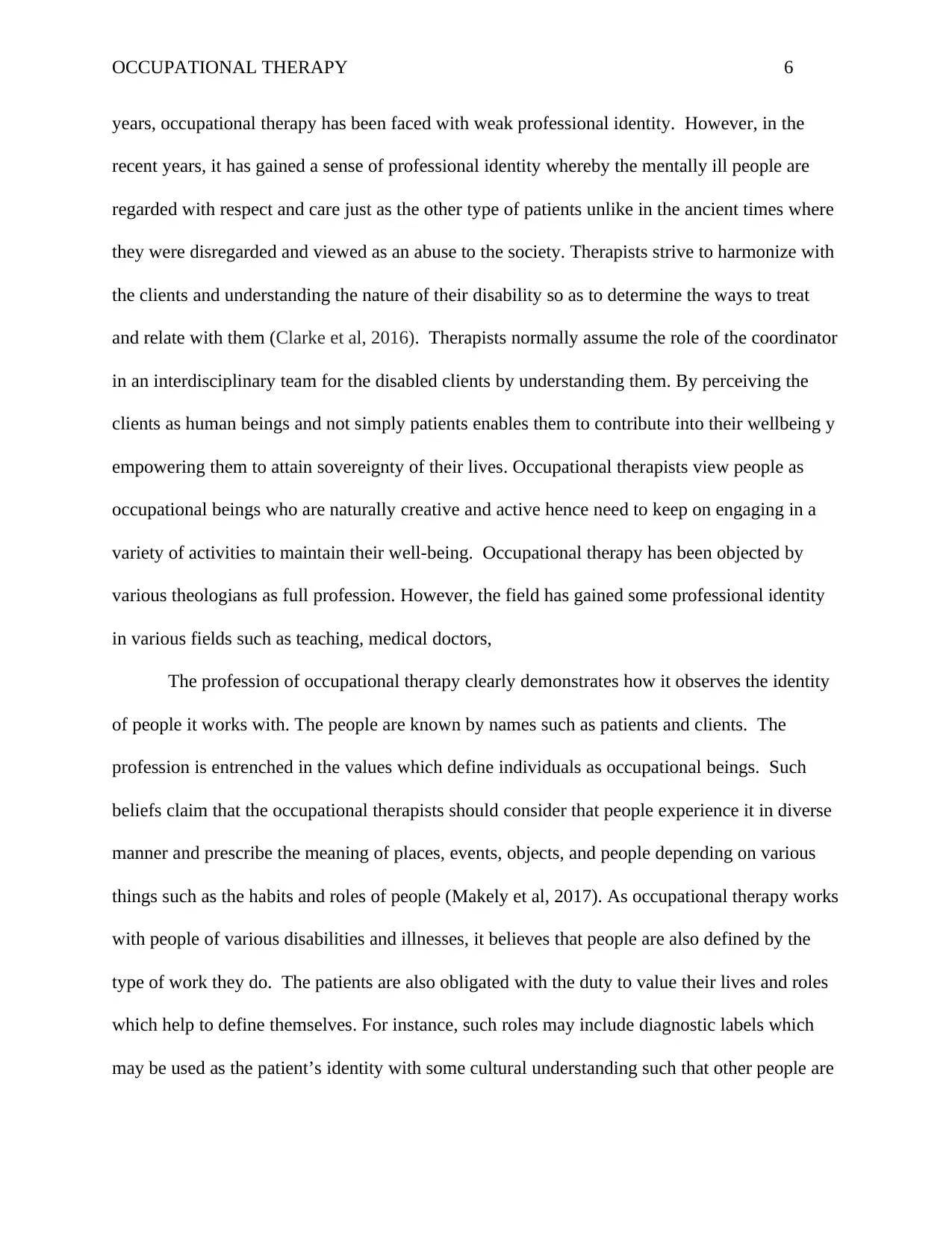
OCCUPATIONAL THERAPY 6
years, occupational therapy has been faced with weak professional identity. However, in the
recent years, it has gained a sense of professional identity whereby the mentally ill people are
regarded with respect and care just as the other type of patients unlike in the ancient times where
they were disregarded and viewed as an abuse to the society. Therapists strive to harmonize with
the clients and understanding the nature of their disability so as to determine the ways to treat
and relate with them (Clarke et al, 2016). Therapists normally assume the role of the coordinator
in an interdisciplinary team for the disabled clients by understanding them. By perceiving the
clients as human beings and not simply patients enables them to contribute into their wellbeing y
empowering them to attain sovereignty of their lives. Occupational therapists view people as
occupational beings who are naturally creative and active hence need to keep on engaging in a
variety of activities to maintain their well-being. Occupational therapy has been objected by
various theologians as full profession. However, the field has gained some professional identity
in various fields such as teaching, medical doctors,
The profession of occupational therapy clearly demonstrates how it observes the identity
of people it works with. The people are known by names such as patients and clients. The
profession is entrenched in the values which define individuals as occupational beings. Such
beliefs claim that the occupational therapists should consider that people experience it in diverse
manner and prescribe the meaning of places, events, objects, and people depending on various
things such as the habits and roles of people (Makely et al, 2017). As occupational therapy works
with people of various disabilities and illnesses, it believes that people are also defined by the
type of work they do. The patients are also obligated with the duty to value their lives and roles
which help to define themselves. For instance, such roles may include diagnostic labels which
may be used as the patient’s identity with some cultural understanding such that other people are
years, occupational therapy has been faced with weak professional identity. However, in the
recent years, it has gained a sense of professional identity whereby the mentally ill people are
regarded with respect and care just as the other type of patients unlike in the ancient times where
they were disregarded and viewed as an abuse to the society. Therapists strive to harmonize with
the clients and understanding the nature of their disability so as to determine the ways to treat
and relate with them (Clarke et al, 2016). Therapists normally assume the role of the coordinator
in an interdisciplinary team for the disabled clients by understanding them. By perceiving the
clients as human beings and not simply patients enables them to contribute into their wellbeing y
empowering them to attain sovereignty of their lives. Occupational therapists view people as
occupational beings who are naturally creative and active hence need to keep on engaging in a
variety of activities to maintain their well-being. Occupational therapy has been objected by
various theologians as full profession. However, the field has gained some professional identity
in various fields such as teaching, medical doctors,
The profession of occupational therapy clearly demonstrates how it observes the identity
of people it works with. The people are known by names such as patients and clients. The
profession is entrenched in the values which define individuals as occupational beings. Such
beliefs claim that the occupational therapists should consider that people experience it in diverse
manner and prescribe the meaning of places, events, objects, and people depending on various
things such as the habits and roles of people (Makely et al, 2017). As occupational therapy works
with people of various disabilities and illnesses, it believes that people are also defined by the
type of work they do. The patients are also obligated with the duty to value their lives and roles
which help to define themselves. For instance, such roles may include diagnostic labels which
may be used as the patient’s identity with some cultural understanding such that other people are
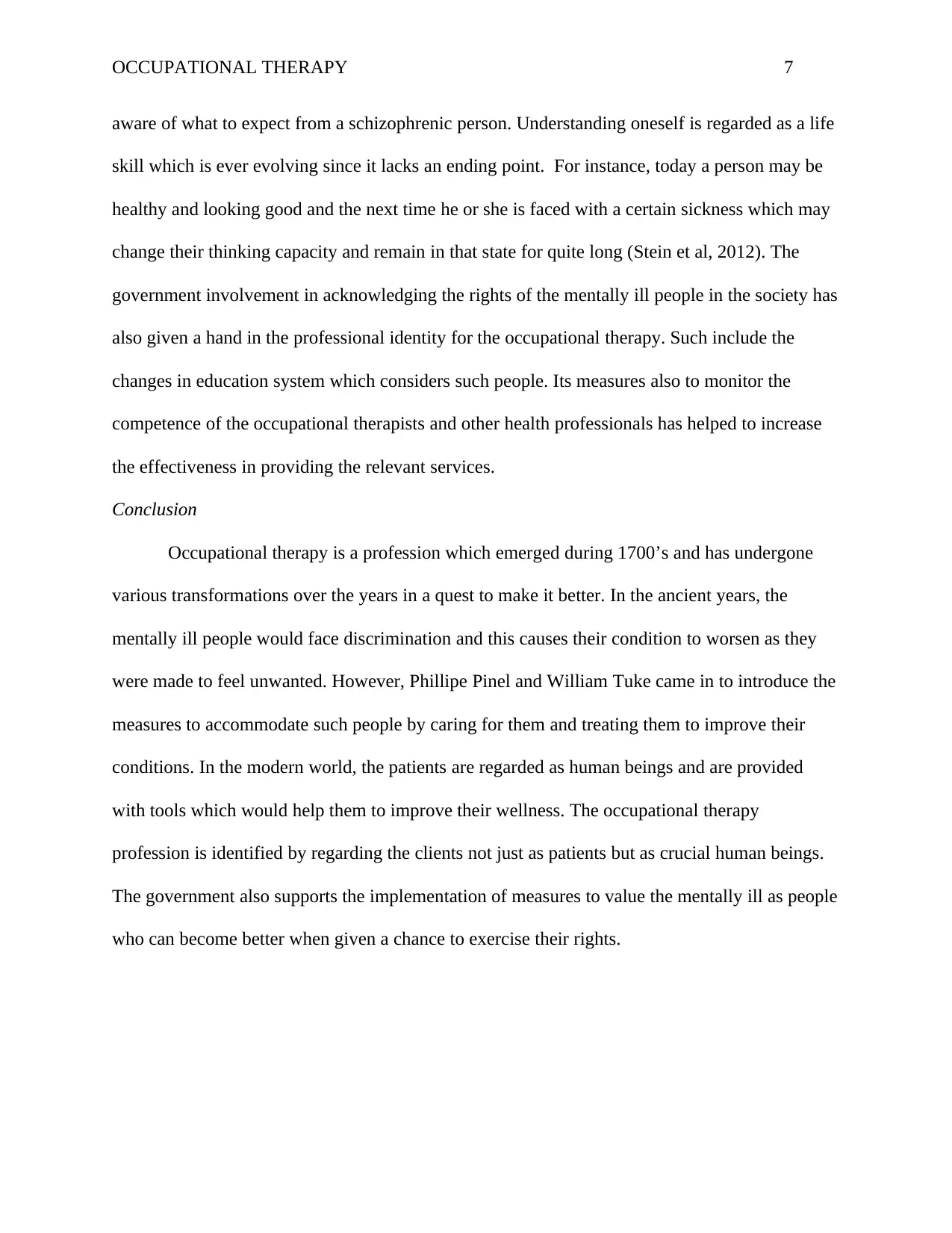
OCCUPATIONAL THERAPY 7
aware of what to expect from a schizophrenic person. Understanding oneself is regarded as a life
skill which is ever evolving since it lacks an ending point. For instance, today a person may be
healthy and looking good and the next time he or she is faced with a certain sickness which may
change their thinking capacity and remain in that state for quite long (Stein et al, 2012). The
government involvement in acknowledging the rights of the mentally ill people in the society has
also given a hand in the professional identity for the occupational therapy. Such include the
changes in education system which considers such people. Its measures also to monitor the
competence of the occupational therapists and other health professionals has helped to increase
the effectiveness in providing the relevant services.
Conclusion
Occupational therapy is a profession which emerged during 1700’s and has undergone
various transformations over the years in a quest to make it better. In the ancient years, the
mentally ill people would face discrimination and this causes their condition to worsen as they
were made to feel unwanted. However, Phillipe Pinel and William Tuke came in to introduce the
measures to accommodate such people by caring for them and treating them to improve their
conditions. In the modern world, the patients are regarded as human beings and are provided
with tools which would help them to improve their wellness. The occupational therapy
profession is identified by regarding the clients not just as patients but as crucial human beings.
The government also supports the implementation of measures to value the mentally ill as people
who can become better when given a chance to exercise their rights.
aware of what to expect from a schizophrenic person. Understanding oneself is regarded as a life
skill which is ever evolving since it lacks an ending point. For instance, today a person may be
healthy and looking good and the next time he or she is faced with a certain sickness which may
change their thinking capacity and remain in that state for quite long (Stein et al, 2012). The
government involvement in acknowledging the rights of the mentally ill people in the society has
also given a hand in the professional identity for the occupational therapy. Such include the
changes in education system which considers such people. Its measures also to monitor the
competence of the occupational therapists and other health professionals has helped to increase
the effectiveness in providing the relevant services.
Conclusion
Occupational therapy is a profession which emerged during 1700’s and has undergone
various transformations over the years in a quest to make it better. In the ancient years, the
mentally ill people would face discrimination and this causes their condition to worsen as they
were made to feel unwanted. However, Phillipe Pinel and William Tuke came in to introduce the
measures to accommodate such people by caring for them and treating them to improve their
conditions. In the modern world, the patients are regarded as human beings and are provided
with tools which would help them to improve their wellness. The occupational therapy
profession is identified by regarding the clients not just as patients but as crucial human beings.
The government also supports the implementation of measures to value the mentally ill as people
who can become better when given a chance to exercise their rights.
Paraphrase This Document
Need a fresh take? Get an instant paraphrase of this document with our AI Paraphraser
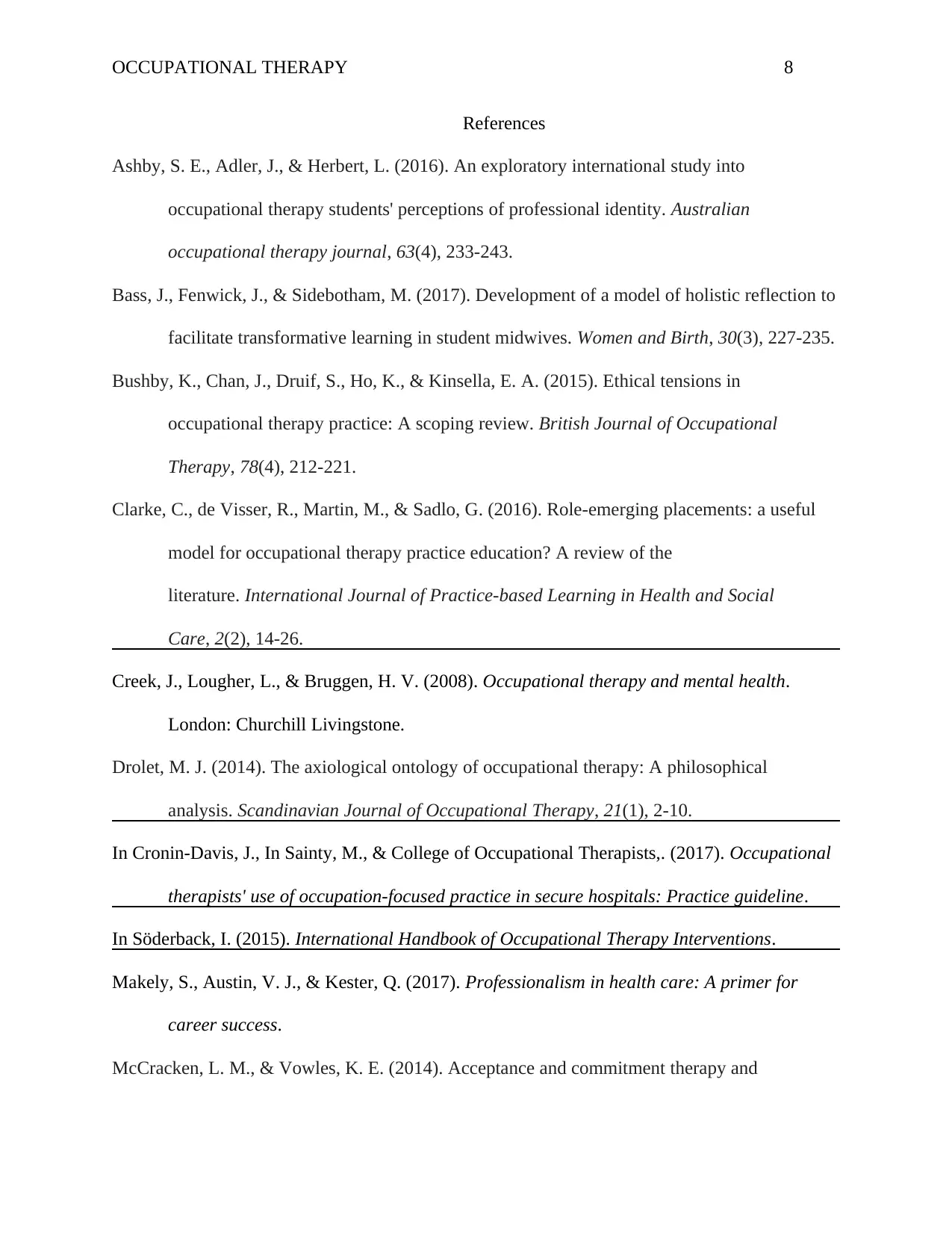
OCCUPATIONAL THERAPY 8
References
Ashby, S. E., Adler, J., & Herbert, L. (2016). An exploratory international study into
occupational therapy students' perceptions of professional identity. Australian
occupational therapy journal, 63(4), 233-243.
Bass, J., Fenwick, J., & Sidebotham, M. (2017). Development of a model of holistic reflection to
facilitate transformative learning in student midwives. Women and Birth, 30(3), 227-235.
Bushby, K., Chan, J., Druif, S., Ho, K., & Kinsella, E. A. (2015). Ethical tensions in
occupational therapy practice: A scoping review. British Journal of Occupational
Therapy, 78(4), 212-221.
Clarke, C., de Visser, R., Martin, M., & Sadlo, G. (2016). Role-emerging placements: a useful
model for occupational therapy practice education? A review of the
literature. International Journal of Practice-based Learning in Health and Social
Care, 2(2), 14-26.
Creek, J., Lougher, L., & Bruggen, H. V. (2008). Occupational therapy and mental health.
London: Churchill Livingstone.
Drolet, M. J. (2014). The axiological ontology of occupational therapy: A philosophical
analysis. Scandinavian Journal of Occupational Therapy, 21(1), 2-10.
In Cronin-Davis, J., In Sainty, M., & College of Occupational Therapists,. (2017). Occupational
therapists' use of occupation-focused practice in secure hospitals: Practice guideline.
In Söderback, I. (2015). International Handbook of Occupational Therapy Interventions.
Makely, S., Austin, V. J., & Kester, Q. (2017). Professionalism in health care: A primer for
career success.
McCracken, L. M., & Vowles, K. E. (2014). Acceptance and commitment therapy and
References
Ashby, S. E., Adler, J., & Herbert, L. (2016). An exploratory international study into
occupational therapy students' perceptions of professional identity. Australian
occupational therapy journal, 63(4), 233-243.
Bass, J., Fenwick, J., & Sidebotham, M. (2017). Development of a model of holistic reflection to
facilitate transformative learning in student midwives. Women and Birth, 30(3), 227-235.
Bushby, K., Chan, J., Druif, S., Ho, K., & Kinsella, E. A. (2015). Ethical tensions in
occupational therapy practice: A scoping review. British Journal of Occupational
Therapy, 78(4), 212-221.
Clarke, C., de Visser, R., Martin, M., & Sadlo, G. (2016). Role-emerging placements: a useful
model for occupational therapy practice education? A review of the
literature. International Journal of Practice-based Learning in Health and Social
Care, 2(2), 14-26.
Creek, J., Lougher, L., & Bruggen, H. V. (2008). Occupational therapy and mental health.
London: Churchill Livingstone.
Drolet, M. J. (2014). The axiological ontology of occupational therapy: A philosophical
analysis. Scandinavian Journal of Occupational Therapy, 21(1), 2-10.
In Cronin-Davis, J., In Sainty, M., & College of Occupational Therapists,. (2017). Occupational
therapists' use of occupation-focused practice in secure hospitals: Practice guideline.
In Söderback, I. (2015). International Handbook of Occupational Therapy Interventions.
Makely, S., Austin, V. J., & Kester, Q. (2017). Professionalism in health care: A primer for
career success.
McCracken, L. M., & Vowles, K. E. (2014). Acceptance and commitment therapy and
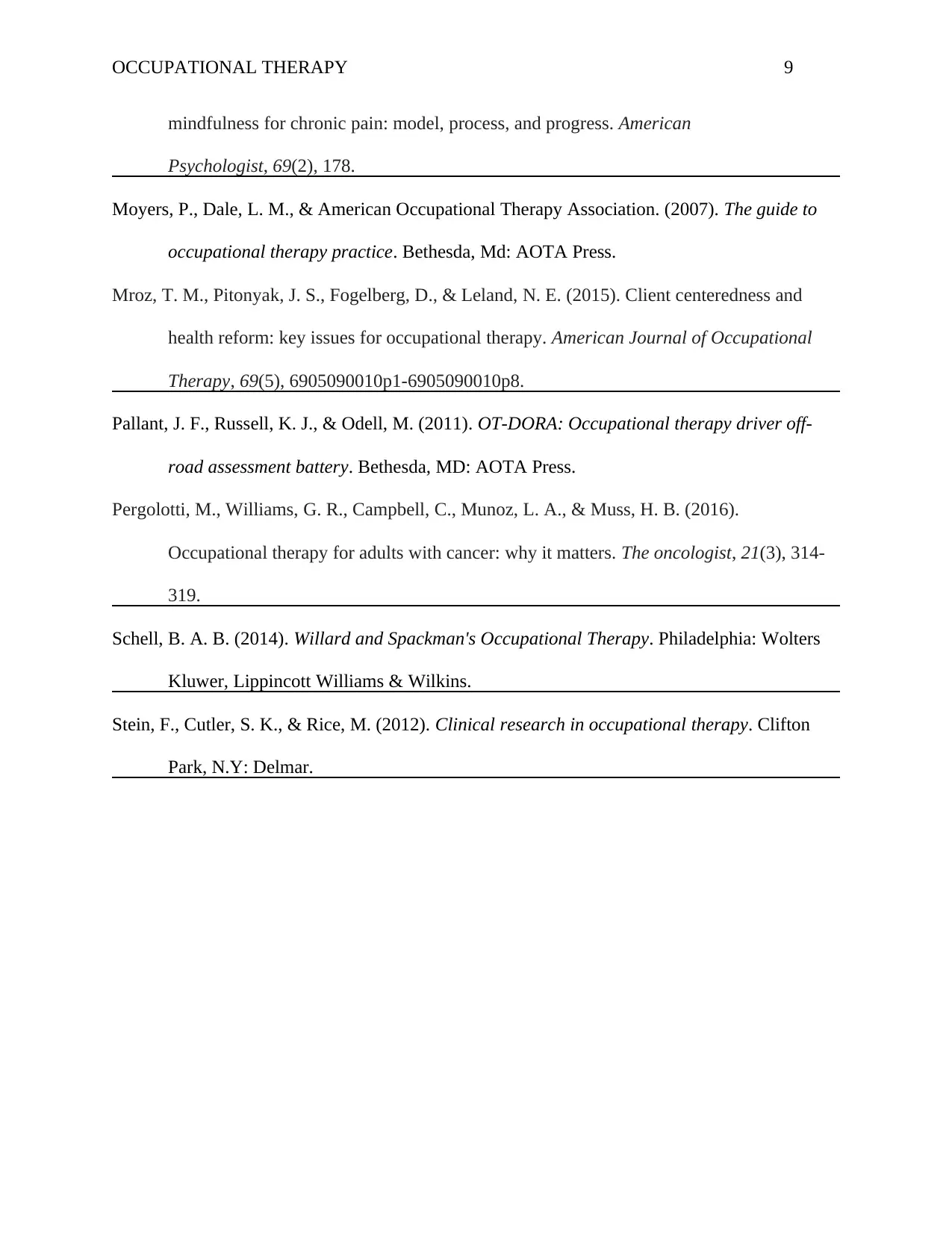
OCCUPATIONAL THERAPY 9
mindfulness for chronic pain: model, process, and progress. American
Psychologist, 69(2), 178.
Moyers, P., Dale, L. M., & American Occupational Therapy Association. (2007). The guide to
occupational therapy practice. Bethesda, Md: AOTA Press.
Mroz, T. M., Pitonyak, J. S., Fogelberg, D., & Leland, N. E. (2015). Client centeredness and
health reform: key issues for occupational therapy. American Journal of Occupational
Therapy, 69(5), 6905090010p1-6905090010p8.
Pallant, J. F., Russell, K. J., & Odell, M. (2011). OT-DORA: Occupational therapy driver off-
road assessment battery. Bethesda, MD: AOTA Press.
Pergolotti, M., Williams, G. R., Campbell, C., Munoz, L. A., & Muss, H. B. (2016).
Occupational therapy for adults with cancer: why it matters. The oncologist, 21(3), 314-
319.
Schell, B. A. B. (2014). Willard and Spackman's Occupational Therapy. Philadelphia: Wolters
Kluwer, Lippincott Williams & Wilkins.
Stein, F., Cutler, S. K., & Rice, M. (2012). Clinical research in occupational therapy. Clifton
Park, N.Y: Delmar.
mindfulness for chronic pain: model, process, and progress. American
Psychologist, 69(2), 178.
Moyers, P., Dale, L. M., & American Occupational Therapy Association. (2007). The guide to
occupational therapy practice. Bethesda, Md: AOTA Press.
Mroz, T. M., Pitonyak, J. S., Fogelberg, D., & Leland, N. E. (2015). Client centeredness and
health reform: key issues for occupational therapy. American Journal of Occupational
Therapy, 69(5), 6905090010p1-6905090010p8.
Pallant, J. F., Russell, K. J., & Odell, M. (2011). OT-DORA: Occupational therapy driver off-
road assessment battery. Bethesda, MD: AOTA Press.
Pergolotti, M., Williams, G. R., Campbell, C., Munoz, L. A., & Muss, H. B. (2016).
Occupational therapy for adults with cancer: why it matters. The oncologist, 21(3), 314-
319.
Schell, B. A. B. (2014). Willard and Spackman's Occupational Therapy. Philadelphia: Wolters
Kluwer, Lippincott Williams & Wilkins.
Stein, F., Cutler, S. K., & Rice, M. (2012). Clinical research in occupational therapy. Clifton
Park, N.Y: Delmar.
1 out of 9
Related Documents
Your All-in-One AI-Powered Toolkit for Academic Success.
+13062052269
info@desklib.com
Available 24*7 on WhatsApp / Email
![[object Object]](/_next/static/media/star-bottom.7253800d.svg)
Unlock your academic potential
© 2024 | Zucol Services PVT LTD | All rights reserved.





